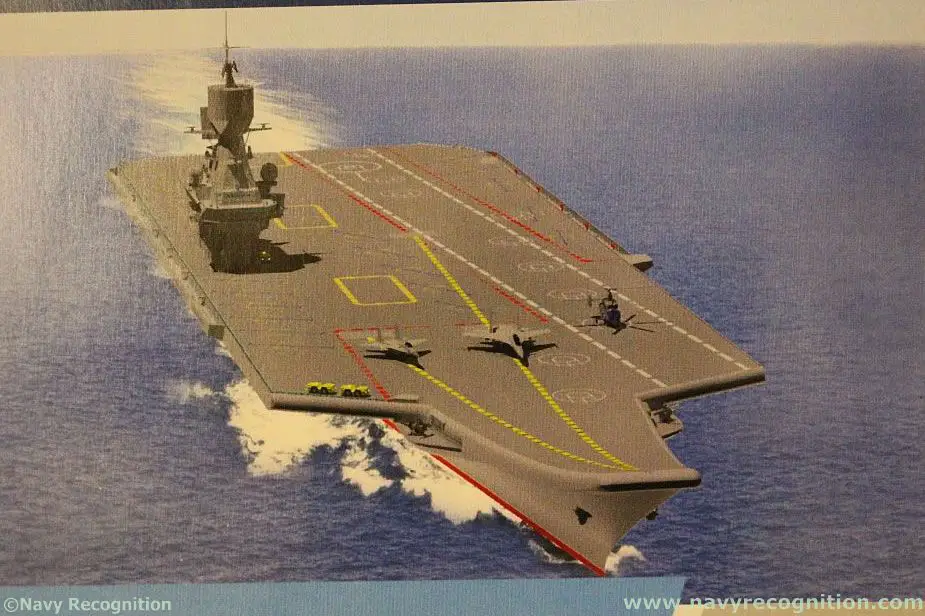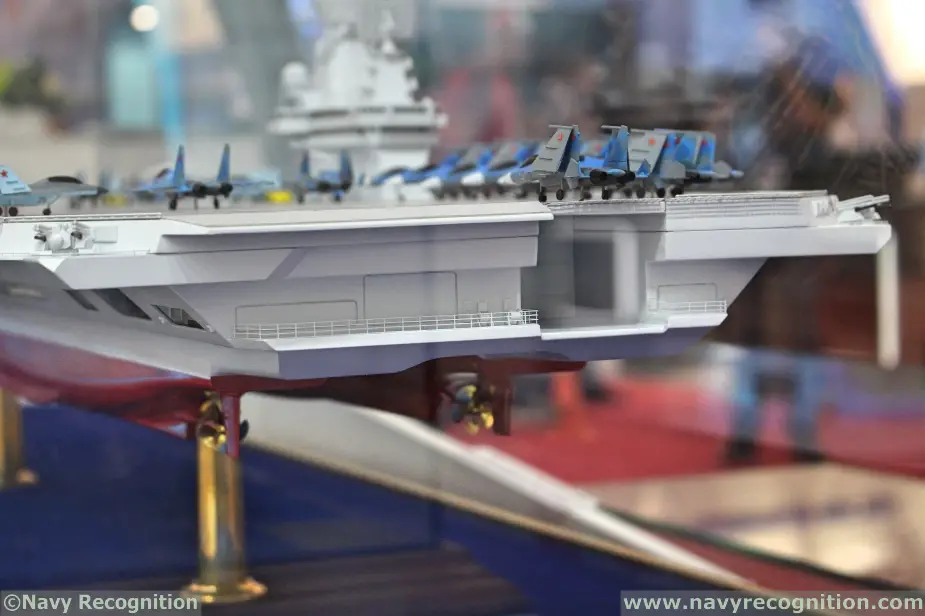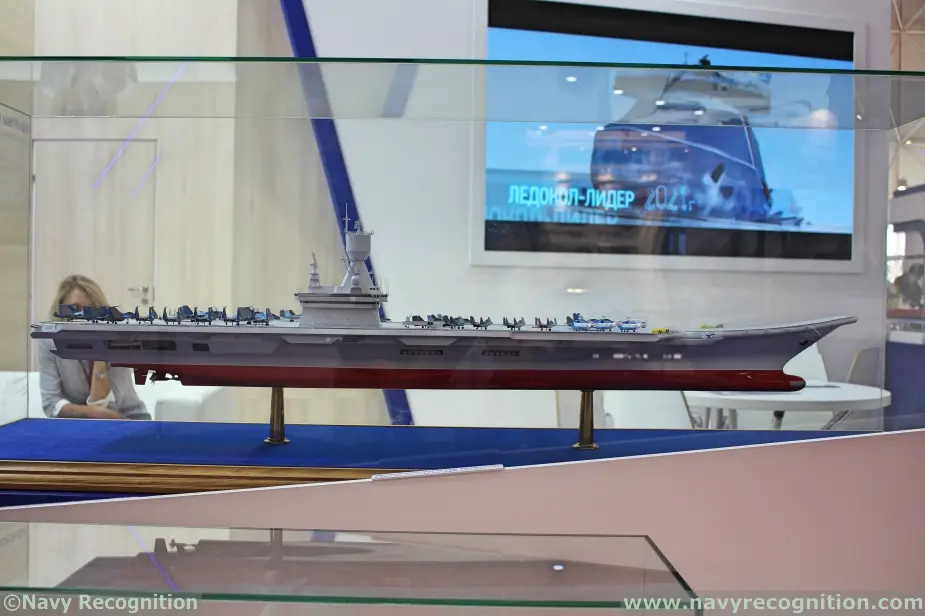The Storm-KM has a flight deck just little smaller than a US CVN. It is a breakthrough and highly significant not only in terms of number of aircraft on board but also in regards of staging / sortie generation capabilities.
There is risk involved but the potential pay off should be enormous... a lighter ship means cheaper more effective propulsion which means more space for aviation fuel and weapons and aircraft... and that is what an aircraft carrier is about... it is not about weight... they talk about weight because that means aircraft capacity and it is aircraft capacity that is what it is all about.
It is better to have the capacity and not need it than not have enough... they can have a 60K ton carrier with a smart cat design that is designed for 90 fighters and 6 AWACs sized fixed wing aircraft and 10 anti sub and support high speed helicopters, as well as a dozen drones for various purposes and never actually operate it with all those vehicles. Operationally it might go to sea with 24 fighter aircraft.... or perhaps 36... where 12 will be Su-57s and 24 are MiG-35s and later LMFS fighters, plus 10 helicopters because they are just useful, and maybe 3 AWACS aircraft and a few dozen drones to round it out... with full onboard aircraft fuel loads the smaller number of aircraft can be operated for two or three times as many flights and there will be plenty of room for all sorts of munitions, but most will be AAMs...
A lighter carrier operating with reduced aircraft loads should be rather cheaper to operate yet still effective when needed.
Maybe they should start building some smaller demonstrators to learn a bit about the new layout in practice.
I was hoping the new helicopter carriers would seem rather too light as that might suggest they were cat based designs but being 40K ton I suspect they have gone for a heavy more capable Mistral design... which is safe and should result in a good ship.
As I keep saying they don't need enormous numbers of CVN fixed wing carriers... together with the Kuz two should be enough most of the time because I doubt they would have an operational fleet big enough for more than two independent carrier groups and I rather suspect they will add extra ships and subs to such groupings to make them more powerful anyway... as opposed to having more separate groups.
I think VMF is more inclined to your (mine too) position than to mini carriers and the like, so they will probably develop full blown solutions with complete air wing, other approach is simply not enough to stand their ground far from Russia and cannot be used at those times where military capability is actually needed.
It is not just Soviet/Russian experience with small carriers.... the French and UK are not buying mini carriers... the French have the CdG which is about 40K ton and everyone claims would be good for Russia but the replacement is planned to be 75K ton and nuclear powered and with cats, and the British carriers are bigger than 40K ton too and neither France nor the UK can afford to piss away money either... no one can except the US and even that might change simply because everything they make is too expensive even for their pockets.
Having said that, high TWR fighters like Su-57 with 2nd stage engines and A2A loadout may not need cats at all, which is very good because wear and maintenance, lack of reliability, needed crewing, spares etc etc plus reduction of sortie rate are hardly something you want to be forced to use to operate your airwing. But AWACS / tankers / low TWR attack aircraft may indeed need those. In that case, having maybe a couple of them at the angled deck while the bow keeps the ramp for fighters would be a quite solid compromise.
They would be useful just for safety to ensure safe operations of aircraft at any weight... certainly Su-57s with full fuel and an air to air payload should be able to operate from a ski jump without cat assistance, and any MiG-35 or LMFS should be able to manage the same... it should only be tankers and AWACS aircraft that should require cats, but I think drones would benefit from their own cats too... design the drones to be very strong to allow high g acceleration takeoffs and their cats could be relatively short and compact and yet get quite heavy drones airborne efficiently too.
I think technology in terms of electric propulsion and electric motors and super magnets and superconductor materials and EM technology is well worth developing and progressing and putting real money into because it is not just useful in land and sea and air and sub sea and space vehicles... the coaxial main rotor of a Kamov helicopter makes it excellent for use on ships because with no swinging tail rotor it is much safer... but with electric drives controlling each rotor there is no need for the 5 ton gearbox the Helix needs to transmit the power to the two sets of main rotors... you get the huge boost in lift... all the engine power goes to lifting and flying the aircraft instead of just keeping the nose pointed where you want it, without the weight issues...
Exactly, displacement and drag would be monstrous. Krylov reported -20/30% propulsive needs, means less cost, volume, displacement, crew and crucially fuel, that can be used for other more useful purposes.
For a nuclear powered vessel it means fewer plants that take up less room on the ship freeing up space for other things... using azipods would also make it very manouverable and able to handle itself without support, and as I said an innovation could be to add trim angle to the pods to allow planing at speed which should further improve performance.
If it is capable of making 15-20 kt on nuclear power without range limits and 30 kt with the GT booster, then it is quite ok I guess, and the saved space can be used for aviation fuel, that is crucial for a carrier. I think they would not need 2 kT of bombs on board as US CVN, they would manage with a fraction of that and a composition of capable AAM and AShM, plus of course a better and deeper SAM storage.
I agree, but I think nuke power should allow them excess electrical power, so GT would be limited to emergency electricity generation... it could be designed to operate using the same fuel the aircraft use so you don't need multiple different types of fuels on board... the propulsion system could be nuclear electric, with Azi pods for propulsion.
Agree regarding ordinance... in situations with landing forces perhaps the LMFS might be unified with the PAK light fighter and PAK light CAS replacement for the Su-25, or if they are separate aircraft they could make a naval carrier based version of the latter that could be operated on big CVNs for landing operations with the helicopter carriers carrying helicopters and drones.
I am not sure pods are a need in this type of vessel,
They would be useful and would also allow the carrier to maintain station efficiently with the main runway pointing into the wind in absence of tugs for air operations even if the wind direction moves a bit.
The pods are also compact and don't take up the room or have the enormous weight of the drive shafts and enormous propellers normally used and of course the reduction gear and gearbox is in the pods which means you can place the nuclear reactors anywhere in the ship.... they don't need to be physically attached to the transmission which has the drive shafts coming out of it.
The centre of a ship is often a target for many types of weapons... having your NPPs separated and properly spaced limits the chance of one instance of battle damage taking down the entire power generation potential of the ship.
The gas turbine auxiliary emergency power source could be in the top of the island itself...
but indeed an all electric propulsion would be interesting coupled with NPP and the associated electrical conversion ancillaries would help implement catapults, radars, DEW and all increasingly electrical equipment onboard. Using the power conversion equipment developed for aircraft can be very advantageous too, since Russia is leading the way in using superconductivity to remove weight, volume and losses from those devices. For instance, the Yak-40 with superconductive engine or the new AC rectifier developed by MAI:
They have time to further develop these technologies and use them in a system where they would actually make a real difference and improve performance.
I would think a high speed helicopter with electric motors and coaxial rotor design would hugely benefit from new all electric technology...



 SeigSoloyvov
SeigSoloyvov

